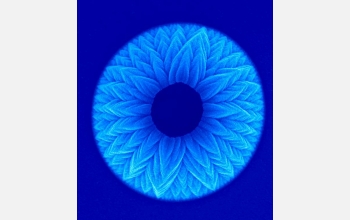Multimedia Gallery
3-D Nanosctructures--"Nano Flower" (Image 2)
A "Nano Flower," a 3-D nanostructure grown by controlled nucleation of silicon carbide nanowires on gallium catalyst particles. As the growth proceeds, individual nanowires "knit" together to form 3-D structures.
This photomicrograph was taken by Ghim Wei Ho, a Ph.D. student studying nanotechnology at the University of Cambridge. Ho--who works with professor Mark Welland, head of Cambridge's Nanoscale Science Lab--makes new types of materials based on nanotechnology (this "Nano Flower" is an example of new material). Nanometer-scale wires (about one thousandth the diameter of a human hair) of a silicon-carbon material (silicon carbide) are grown from tiny droplets of a liquid metal (gallium) on a silicon surface, like the chips inside our home computers. The wires grow as a gas containing methane flows over the surface. The gas reacts at the surface of the droplets and condenses to form the wires. By changing the temperature and pressure of the growth process the wires can be controllably fused together in a natural process to form a range of new structures, including these flower-like materials. Researchers are investigating possible applications for the structures like water repellant coatings and as a base for a new type of solar cell.
Note: All the images in the "3-D Nanostructure" series were taken with a scanning electron microscope. Image color was modified using Adobe Photoshop. (Year of image: 2004) [Image 2 of 3 related images. See Image 3.]
Credit: ©Ghim Wei Ho and Prof. Mark Welland, Nanostructure Center, University of Cambridge
Special Restrictions: All of the images in the T3-D Nanostructure series are ©Ghim Wei Ho and Prof. Mark Welland, University of Cambridge. Permission is granted to use these images for personal, educational and noncommercial/nonprofit use only. Any other use of the images is strictly prohibited.
Images and other media in the National Science Foundation Multimedia Gallery are available for use in print and electronic material by NSF employees, members of the media, university staff, teachers and the general public. All media in the gallery are intended for personal, educational and nonprofit/non-commercial use only.
Images credited to the National Science Foundation, a federal agency, are in the public domain. The images were created by employees of the United States Government as part of their official duties or prepared by contractors as "works for hire" for NSF. You may freely use NSF-credited images and, at your discretion, credit NSF with a "Courtesy: National Science Foundation" notation.
Additional information about general usage can be found in Conditions.
Also Available:
Download the high-resolution TIFF version of the image. (4.6 MB)
Use your mouse to right-click (Mac users may need to Ctrl-click) the link above and choose the option that will save the file or target to your computer.

